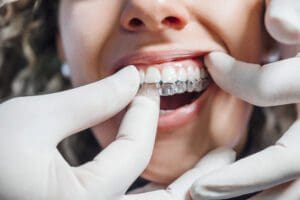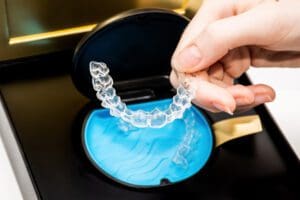Posted on May 25, 2024

The development of clear aligners has revolutionized orthodontic treatment by providing a discreet and comfortable option for patients seeking straighter teeth. However, patients must understand the specific orthodontic problems clear aligners are designed to address and their potential limitations.
Factors such as case complexity, patient goals, and budget play crucial roles in determining suitability for clear aligners. It’s important to consult with a professional orthodontist who can assess individual needs and advise on the most effective options for achieving that perfect smile.
Clear aligners are a popular option for straightening teeth, but they’re not a one-size-fits-all solution. Traditional braces might be necessary when dealing with certain skeletal discrepancies that aligners can’t correct.
For instance, rotating canines and molars could pose challenges due to their shape and position in the mouth.
Clear aligners work well with mild to moderate overbites and underbites. These issues involve the front teeth which are easier for aligners to move. However, cross bites present more of a challenge because they often require precise, multi-directional movements.
Overcrowding may also limit the effectiveness of clear aligners alone. Sometimes additional procedures are necessary to create space before or during treatment with aligners.
The success rate of clear aligners depends on both case complexity and patient compliance. Aligners must be worn consistently—around 22 hours per day—to achieve the desired results.
However, not all tooth movements are feasible with plastic aligners; some may require more force than clear aligners can provide. Patients should have realistic expectations based on professional advice from their dentist or orthodontist regarding potential limitations.
 Clear aligners excel at correcting mild misalignments of teeth. These minor irregularities often require simpler treatment plans, making them ideal for patients seeking a subtle improvement in their smile.
Clear aligners excel at correcting mild misalignments of teeth. These minor irregularities often require simpler treatment plans, making them ideal for patients seeking a subtle improvement in their smile.
The benefits of clear aligners for mild cases contribute to high patient satisfaction:
An orthodontist will always assess the individual’s needs before recommending clear aligners to ensure they are the most suitable option.
Clear aligners are a powerful tool for addressing both crowding and minor spacing issues. They can effectively close small gaps between teeth and often manage moderate crowding without requiring tooth extractions. This is a significant advantage for patients who prefer to avoid tooth removal.
However, for cases with large gaps or severe crowding, traditional braces might offer more precise control over tooth movement. An orthodontist can assess your specific situation and recommend the best approach.
Clear aligners offer a modern solution for straightening teeth. However, they have limitations. Some orthodontic problems are too complex for plastic aligners alone. These may need traditional braces as well. An example is when teeth require rotation or vertical movement.
Orthodontists often suggest a hybrid approach in these cases. It combines clear aligners with other methods to achieve the desired results. This method requires careful planning by an experienced professional.
In severe cases of misalignment, such as significant malocclusions, clear aligners might not be enough. Sometimes, the jaw’s position needs correction through surgery before using aligners. If aligners are used alone for these severe issues, treatment can take much longer than usual.
Clear aligners are versatile and can address a variety of orthodontic issues, including:
Before you jump into clear aligners, an orthodontist will do a checkup to see if they’re right for your smile. They’ll consider a few things:
For clear aligners to work their magic, consistent wear is key. Aim to wear them for 20-22 hours each day. Even missing a few hours here and there can slow down progress. Sticking to the wear schedule is essential for achieving the best results.
Regular check-ups with your orthodontist are important to monitor your progress and make adjustments to your treatment plan as needed. These appointments make sure everything stays on track for your dream smile.
Before starting clear aligners, a thorough oral health assessment is crucial. Healthy gums and teeth are essential for successful treatment. Gum disease or untreated cavities can create complications.
Your orthodontist will typically recommend addressing any gum disease before starting clear aligners to optimize your oral health. They will also ensure all cavities are filled to create a smooth and healthy foundation for your teeth to move into their new positions.
 Clear aligners have become a popular choice for achieving a straighter smile. Compared to traditional braces, they offer several advantages that can make the orthodontic experience more convenient and comfortable.
Clear aligners have become a popular choice for achieving a straighter smile. Compared to traditional braces, they offer several advantages that can make the orthodontic experience more convenient and comfortable.
Here’s a breakdown of some key benefits:
While clear aligners are a great option for many people, they might not be suitable for all cases. Here are some factors to consider:
An orthodontist can assess your individual situation and determine if clear aligners are the right choice for you.
Congratulations on achieving your dream smile with clear aligners! Now, let’s talk about how to keep it that way.
Everyone’s smile is unique, and so are their orthodontic needs. An experienced orthodontist will consider your specific situation and goals to determine if clear aligners are the right choice for you. This personalized approach helps ensure you achieve the best possible results.
If you’re considering clear aligners and want to learn more, schedule a consultation with us at Smilebliss today! We can answer your questions and help you decide if clear aligners are the right path to your dream smile.